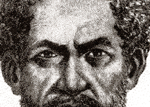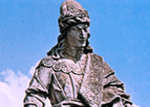Aleijadinho
(1738-1814)
1738 Aleijadinho ("Little Cripple;" aleijado
> Portuguese = cripple) is the professional name by which Antônio Francisco
Lisboa was born in Vila Rica (later changed to Ouro Preto, "dark
gold") in the state of Minas Gerais (General Mines),
His
father was a Portuguese carpenter and architect, Manoel Francisco Lisboa.
His
mother, Izabel, was a black slave, who was given her freedom at the birth of
her son, little Aleijadinho.
1738-1765 The boy suffered a terrible disease in childhood (Portuguese: zamparina), which caused his limbs to be
atrophied throughout his entire life. Due to this handicap, his slaves
(Maurício, Agostinho, Januário) held the tools he used to create his
sculptures.
His
education consisted in music, Latin, reading, writing, design, and
architecture.
1766 The Order of St. Francis of
1777 His disease (leprosy?) caused him to lose the use of
both hands. When he continued working and sculpting despite this terrible
disability, especially for a sculptor, he was given the nickname of Aleijadinho
1777-1812 Rich patrons throughout the state of Minas Gerais awarded him
with many commissions. His best works dates from this period. Among them are
Carmelite churches in Sabará and Ouro Preto, the façade of São Francisco
de Assis da Penitência in Ouro Preto, the sanctuary of Bom Jesus de Matozinhos
(also in the state of Minas Gerais).
1780-1790 He sculpted the gigantic project of 67 statues of the Passion
of Christ at Morro do Maranhão.
1800-1805 He sculpted his masterpiece, 12 Old Testament prophets, in
Congonhas.
1812 He became totally paralyzed.
1814 He died a pauper. He was buried in the Mother Church
of Nossa Senhora da Conceição
(Our Lady of the Conception).
Aleijadinho
is known principally as the single most important genius and the greatest
colonial sculptor in colonial Brazilian culture, art, and the humanities. He
was known as "the little cripple" by his contemporaries. Among his
most significant works is the "ballet of stone" that he created in
the statues on the external balusters of a church stairway at Congonhas. This
ballet of stone has statues of Old Testament prophets like Isaiah, Jeremiah,
Baruch, Ezekiel, Johan, Joel, Daniel, Hosea, and more. One of the statues is of
himself. These statues demonstrate psychological penetration into the
individual character of each figure, and the entire group of twelve statues is
perfectly organized as a complete whole. In Morro do Maranhão, there are
statues on different levels with 67 statues of pilgrim stations of the cross;
each station comprises a complete scene. Aleijadinho has been depicted in films
and television: Cristo de Lama
(1966), Aleijadinho,
Paixão,Glória e Suplício (2003), and a Brazilian TV special. An on-line comment in Porgutuese
says the following about his masterpieces: "Quando uma obra isolada do mestre escultor está diante de nossos olhos,
ficamos com a impressão de que
nela existe vida (When each separate one of the master sculptor's works is placed
before our eyes we are struck with an impression that life exists in it.).
For
a photographic tour of some of Aleijadinho's works, click on the following
image:




